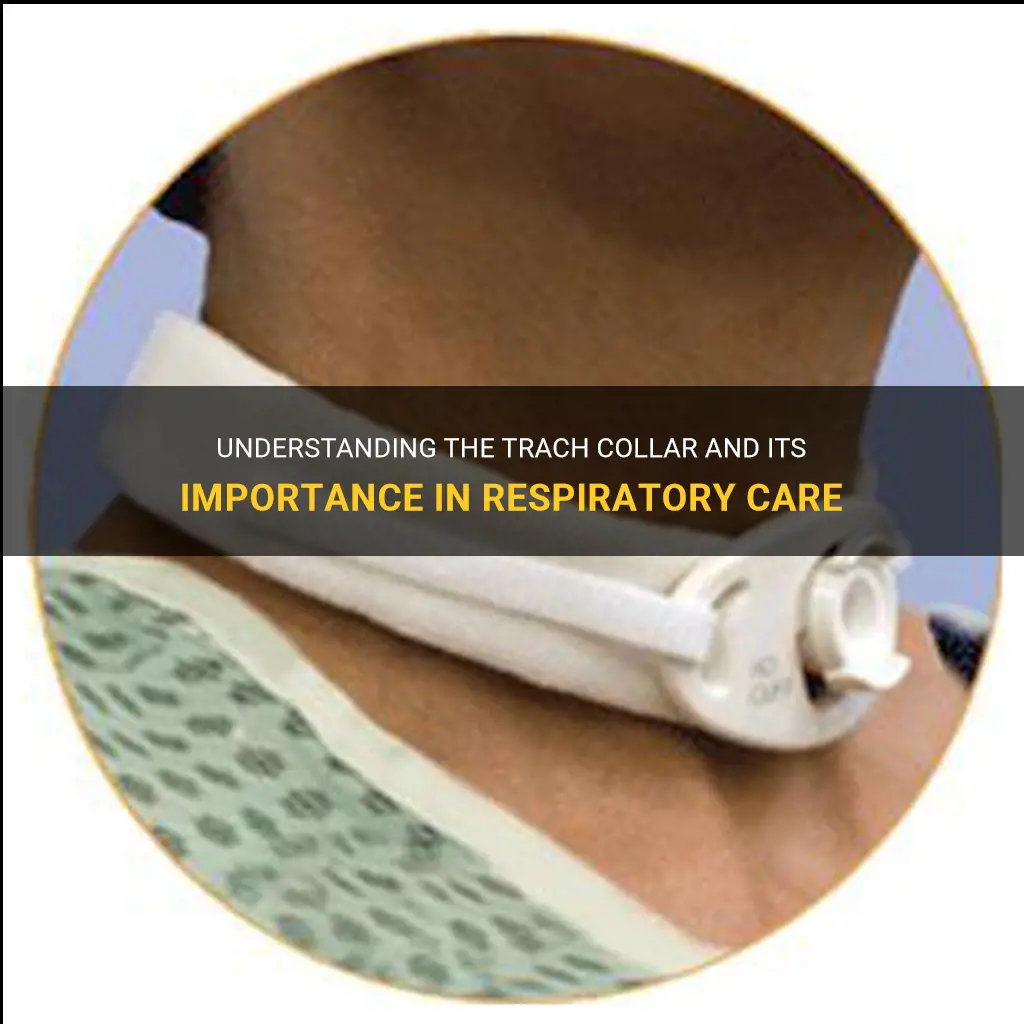
A trach collar, also known as a tracheostomy collar, is a medical device that is used to deliver oxygen to patients who have undergone a tracheostomy procedure. This collar is designed to fit around the patient's neck and offers a convenient and effective way of delivering oxygen directly to the lungs. Whether used in a hospital setting or at home, trach collars provide a vital lifeline for patients with breathing difficulties and have revolutionized the way respiratory care is administered. In this article, we will explore the uses, benefits, and considerations of using a trach collar, as well as its impact on patient comfort and overall well-being.
| Characteristic | Value |
|---|---|
| Purpose | To deliver oxygen through a tracheostomy tube directly to the lungs |
| Design | Collar-shaped device |
| Material | Varies; typically latex-free |
| Size | Comes in different sizes to fit different patients |
| Connection | Connects to an oxygen source via tubing |
| Adjustable | Usually adjustable to ensure a proper fit |
| Cuff | May have an inflatable cuff to create a seal around the tracheostomy site |
| Cleaning | Can be cleaned with soap and water or disinfectant wipes |
| Replacement | Should be replaced regularly to maintain its effectiveness |
| Usage | Used for short-term or long-term oxygen therapy in tracheostomized patients |
What You'll Learn
- What is a trach collar and what is its purpose?
- How is a trach collar different from a traditional tracheostomy tube?
- How is a trach collar used in managing patients with a tracheostomy?
- Are there any potential complications or risks associated with using a trach collar?
- What are some common indications for using a trach collar in a respiratory care setting?

What is a trach collar and what is its purpose?
A trach collar, also known as a tracheostomy collar, is a medical device used to deliver oxygen therapy to patients who have a tracheostomy tube in place. It is essentially a small respiratory mask that fits over the trach tube and is secured in place with adjustable straps. The purpose of the trach collar is to provide supplemental oxygen to the patient, ensuring that they receive an adequate amount of oxygen to support their breathing.
When a person undergoes a tracheostomy, a small surgical opening is created in the front of their neck to access their trachea, or windpipe. This opening is then fitted with a tracheostomy tube, which allows air to pass directly into the lungs. Often, patients who require a tracheostomy have some degree of respiratory compromise and may require the use of supplemental oxygen.
The trach collar is connected to an oxygen source, such as an oxygen concentrator or portable oxygen tank, via a small tubing. The oxygen is then delivered to the patient through the collar, which covers the stoma, or the opening of the trach tube. The collar is designed to create a seal around the stoma, preventing the escape of oxygen and ensuring that it is directed towards the patient's airway.
The trach collar is usually worn continuously by patients who require ongoing oxygen therapy. The flow rate of the oxygen can be adjusted to meet the individual patient's needs, and it is often prescribed by a healthcare professional based on the patient's oxygen saturation levels and respiratory status. The collar is comfortable and lightweight, allowing the patient to move and perform daily activities without restriction.
In addition to providing oxygen therapy, the trach collar can also be used to deliver humidity or nebulized medications directly to the patient's airway. This is particularly beneficial for patients with respiratory conditions such as chronic obstructive pulmonary disease (COPD) or cystic fibrosis, as it helps to moisturize the airways and loosen mucus.
Using a trach collar requires proper care and maintenance to ensure that it remains clean and functioning effectively. The collar should be cleaned regularly with mild soap and water, and the straps should be checked for any signs of wear or stretching. It is important to follow the manufacturer's instructions for use and seek guidance from a healthcare professional if any issues arise.
In conclusion, a trach collar is a medical device that is used to provide oxygen therapy to patients with a tracheostomy tube. Its purpose is to deliver supplemental oxygen directly to the patient's airway, ensuring that they receive an adequate amount of oxygen to support their breathing. The trach collar is comfortable, lightweight, and allows for the delivery of humidity or medications. With proper care and maintenance, the trach collar can be a valuable tool in respiratory care for patients with tracheostomies.
Understanding the Benefits and Uses of a Tracheostomy Collar
You may want to see also

How is a trach collar different from a traditional tracheostomy tube?
A tracheostomy is a surgical procedure in which a small opening is made in the front of the neck and a tube is inserted into the windpipe to help a person breathe. This procedure is typically done when a person has difficulty breathing and needs long-term assistance or when there is a blockage in the airway.
Traditionally, a tracheostomy tube is used to maintain the opening in the windpipe. This tube is inserted during the surgical procedure and can be either cuffed or uncuffed. The cuff is a balloon-like device that can be inflated to create a seal around the windpipe, preventing air from escaping and allowing for ventilation. The tracheostomy tube is connected to a ventilator or oxygen source to provide breathing support.
However, in some cases, a trach collar may be used instead of a traditional tracheostomy tube. A trach collar is a device that is placed over the stoma (the opening in the neck) and connected to a ventilator or oxygen source via a small, flexible tube. The trach collar is designed to deliver oxygen or assist with ventilation without the need for an inserted tube.
There are several key differences between a trach collar and a traditional tracheostomy tube. One significant difference is that a trach collar does not require an invasive procedure to insert and remove. Instead, it can be placed over the stoma and secured with straps. This makes it a more comfortable option for some individuals, as the tube is not present in the windpipe.
Additionally, a trach collar allows for greater mobility and freedom of movement compared to a traditional tracheostomy tube. With a trach collar, the individual can move around more easily and perform daily activities without the cumbersome presence of a tube.
Another benefit of a trach collar is that it can be easily adjusted to deliver the desired amount of oxygen or ventilation. The flow can be adjusted by changing the settings on the device, allowing for precise control of the amount of support provided.
Some possible drawbacks of using a trach collar include the potential for skin irritation or pressure sores around the stoma, as the device is in constant contact with the skin. Regular cleaning and care of the stoma area can help minimize these risks.
Overall, the use of a trach collar provides a viable alternative to a traditional tracheostomy tube for individuals who require long-term ventilation or oxygen support. It offers greater comfort, mobility, and ease of use, while still providing the necessary respiratory assistance. However, the decision to use a trach collar versus a traditional tracheostomy tube should be made in consultation with a healthcare professional, as individual needs and circumstances may vary.
Essential Steps for Changing a Tracheostomy Inner Cannula: A Complete Guide
You may want to see also

How is a trach collar used in managing patients with a tracheostomy?
A tracheostomy is a surgical procedure in which a small opening is made in the front of the neck to access the trachea, or windpipe. This opening, called a stoma, allows for breathing and can be temporary or permanent, depending on the patient's condition.
Once a tracheostomy has been performed, managing the patient's airway becomes crucial. One of the tools commonly used in this process is a trach collar. A trach collar is a device that is placed over the stoma to provide supplemental oxygen and help manage the patient's respiratory needs.
Here is a step-by-step guide on how a trach collar is used in managing patients with a tracheostomy:
- Assess the patient's respiratory status: Before applying a trach collar, it is essential to assess the patient's respiratory status. This includes evaluating their oxygen saturation levels, respiratory rate, and overall airway patency.
- Preparing the trach collar: The trach collar consists of several components, including a connector, oxygen supply tubing, and a face mask or tracheostomy tube adapter. Ensure that all these components are clean and in good condition before use.
- Applying the trach collar: Gently place the face mask or tracheostomy tube adapter over the stoma, ensuring a secure and snug fit. If using a face mask, position it over the patient's nose and mouth, making sure it covers both adequately. If using a tracheostomy tube adapter, connect it to the trach collar's connector.
- Connecting the oxygen supply: Attach the oxygen supply tubing to the trach collar by firmly connecting it to the connector. Ensure that the oxygen flow rate is set to the prescribed level by adjusting the flow meter.
- Adjusting the fit: Check that the trach collar is properly fitted and that there are no air leaks. Adjust any straps or fasteners to ensure a comfortable yet secure fit. This will help prevent excessive movement of the trach collar during use.
- Administering supplemental oxygen: Activate the oxygen flow by opening the oxygen valve or turning on the oxygen concentrator. Monitor the patient's oxygen saturation levels closely to ensure they are receiving the desired amount of supplemental oxygen.
- Monitoring the patient: Once the trach collar is in place and oxygen is being administered, continue to monitor the patient's respiratory status. Regularly check their oxygen saturation levels, respiratory rate, and signs of distress or discomfort.
It is important to note that the use of a trach collar should be supervised by a healthcare professional experienced in managing patients with tracheostomies. They will be able to provide proper guidance and support, as well as adjust the oxygen flow rate and other settings as needed.
In conclusion, a trach collar is a valuable tool for managing patients with tracheostomies. It provides supplemental oxygen and helps ensure the patient's respiratory needs are met. By following the steps outlined above and working closely with a healthcare professional, patients with tracheostomies can receive the necessary respiratory support to improve their overall well-being and quality of life.
Understanding the Optimal Tracheostomy Cuff Pressure: What is Normal?
You may want to see also

Are there any potential complications or risks associated with using a trach collar?
A trach collar, also known as a tracheostomy collar, is a medical device used to deliver additional oxygen to a person who has a tracheostomy. It consists of a small oxygen supply tube that is connected to a collar that fits around the neck. The oxygen supply tube connects to a port on the tracheostomy tube, allowing oxygen to be delivered directly to the airway.
While the use of a trach collar can be beneficial for patients with tracheostomies, there are potential complications and risks that need to be considered. These can include:
- Infection: One of the main concerns with using a trach collar is the risk of infection. The tracheostomy tube provides a direct pathway from the outside environment to the airway, which can increase the risk of bacteria or other pathogens entering the airway and causing infection. To minimize this risk, it is important to maintain good hygiene and regularly clean and change the trach collar and tracheostomy tube.
- Skin irritation: The collar that fits around the neck can sometimes cause skin irritation or pressure ulcers. This can occur if the collar is too tight or if it is worn for long periods of time without proper care. To prevent skin irritation, it is important to ensure that the collar is fitted properly and that it is not too tight. Regularly inspecting the skin around the collar and providing proper care can also help prevent irritation.
- Dislodgement or displacement: There is a risk of the trach collar becoming dislodged or displaced, potentially causing difficulties with oxygen delivery. This can occur if the collar is not secured properly or if the patient engages in activities that may cause it to shift. It is important to ensure that the collar is fitted securely and to regularly check its placement to prevent any issues.
- Mucus build-up: People with tracheostomies often have increased mucus production, which can accumulate in the airway and interfere with oxygen delivery. While the trach collar can help deliver oxygen directly to the airway, it may not effectively clear mucus build-up. Regular suctioning and cleaning of the tracheostomy tube may be necessary to maintain proper airway clearance.
- Equipment malfunction: Like any medical device, there is a risk of equipment malfunction with the trach collar. This can include issues with oxygen delivery, such as low flow or inadequate pressure. Regularly checking and maintaining the equipment, as well as having backup systems in place, can help minimize the risk of equipment malfunction.
In summary, while the use of a trach collar can be beneficial for patients with tracheostomies, there are potential complications and risks that need to be considered. These can include infection, skin irritation, dislodgement or displacement, mucus build-up, and equipment malfunction. It is important to closely monitor and manage these risks to ensure the safe and effective use of a trach collar.
Understanding the Life Expectancy of a Baby with a Tracheostomy
You may want to see also

What are some common indications for using a trach collar in a respiratory care setting?
A tracheostomy, also known as a trach collar, is a medical procedure that involves creating a surgical opening in the neck and windpipe to provide a direct airway for breathing. This procedure is typically performed in cases where an individual is unable to breathe through their nose or mouth due to obstruction or injury. Trach collars are commonly used in respiratory care settings to provide long-term airway management for patients with various conditions. Some common indications for using a trach collar include:
- Respiratory Failure: Trach collars are often used in cases of respiratory failure, where the patient's lungs are unable to oxygenate their blood adequately. This can occur due to conditions such as chronic obstructive pulmonary disease (COPD), pneumonia, or acute respiratory distress syndrome (ARDS). By bypassing the upper airway, a trach collar ensures a direct pathway for oxygen delivery to the lungs, thereby improving oxygenation and ventilation.
- Mechanical Ventilation: Trach collars are frequently used as an alternative to endotracheal intubation when long-term mechanical ventilation is required. Unlike an endotracheal tube that is inserted through the mouth and into the trachea, a trach collar allows for a more comfortable and secure airway access. This is particularly beneficial for patients who require prolonged ventilation, such as those with spinal cord injuries or neuromuscular disorders.
- Upper Airway Obstruction: Trach collars are also used in cases of upper airway obstruction, where there is a blockage in the nose, mouth, or throat preventing adequate airflow. This can occur due to conditions such as tumors, trauma, or infections. By creating a direct path to the trachea, a trach collar ensures continuous airflow and prevents asphyxiation.
- Secretion Clearance: Trach collars are commonly utilized for suctioning and clearing respiratory secretions. This is particularly important for patients who have difficulty clearing their secretions due to weak cough or impaired mucociliary clearance. By providing a direct access to the trachea, a trach collar enables healthcare professionals to effectively suction and remove secretions, reducing the risk of pneumonia and other respiratory complications.
- Weaning from Mechanical Ventilation: Trach collars can also be used as a step towards weaning patients off mechanical ventilation. In cases where patients have been on long-term ventilation, a trach collar may be used to provide intermittent ventilatory support while gradually decreasing the level of assistance. This allows the patient's respiratory muscles to regain strength and functionality, eventually leading to successful extubation.
In conclusion, trach collars are commonly used in respiratory care settings for patients with various conditions such as respiratory failure, upper airway obstruction, or the need for long-term mechanical ventilation. They provide a direct and secure airway access, ensuring adequate oxygenation and ventilation while facilitating secretion clearance and weaning from mechanical ventilation. Trach collars play a vital role in enhancing patient outcomes and improving overall respiratory care.
Understanding the Incompatible Tracheostomy Tubes for Passy-Muir Valve Usage
You may want to see also
Frequently asked questions
A trach collar is a medical device that is used to deliver oxygen to individuals who have a tracheostomy tube, which is a tube that is inserted into the windpipe to help with breathing. The trach collar is usually made of soft, flexible material and is placed around the neck, covering the tracheostomy tube. It is connected to an oxygen source and helps to deliver a continuous flow of oxygen to the patient.
A trach collar works by connecting to an oxygen source, such as an oxygen concentrator or a compressed gas cylinder. The oxygen is delivered through a small tube that is attached to the collar and is inserted into the tracheostomy tube. The collar helps to prevent leaks and delivers a consistent flow of oxygen directly into the airway, bypassing the nose and mouth. This can be beneficial for individuals who are unable to breathe properly through their nose and mouth or require higher levels of oxygen.
A trach collar can be beneficial for individuals who have a tracheostomy tube and require supplemental oxygen. This includes individuals who have respiratory conditions such as chronic obstructive pulmonary disease (COPD), pneumonia, or other lung diseases that make it difficult to breathe. It can also be used for individuals who have had surgery or a procedure that requires a tracheostomy tube. Additionally, a trach collar may be used in a hospital or clinical setting for patients who need oxygen therapy for a temporary period of time.







